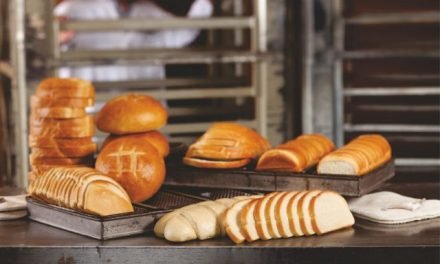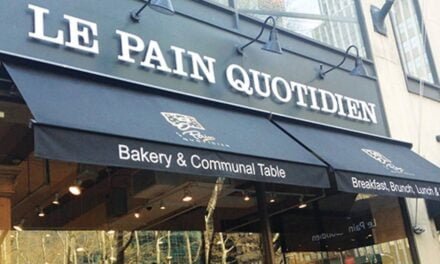The bakery business has considerable scope for additional investment and employment with very fewer capital requirements per unit compared to the other industries. Initial planning of bakery business is of great importance and can benefit the bakers in many ways. Keshav B. Kamaliya explains various steps involved in planning a medium-scale bakery industry.
Steps in Planning a Bakery Business
Bakery business has an important role to play. It holds an immediate and prospective future. It has also considerable scope for additional investment and employment with very few capital requirements. The bakery-owners, however, should plan carefully before they start to operate. A bakery business plan should be formulated properly.
Planning and its Importance in Bakery Business
Planning includes a written summary of what the bakery-owner hope to accomplish by being in business and how he intends to organize the resources to meet his goals. It is the road map for operating any business and measuring progress along the way. It also serves as a blueprint for building a business on solid grounds and making sure that it will withstand the difficult and lean first years. Read more about how to start a bakery unit.
Planning is important as it encourages realism instead of over-optimism. It helps a bakery-owner to identify customers, market area, pricing strategy, and competitive conditions. This process often leads to the discovery of competitive advantage or new opportunities, as well as a deficiency in the plan. By putting plans on paper overall ability to manage the business improves. A bakery-owner would also have time to look ahead and avoid problems before they arise. He will be able to make improvements enter in the plan before conditions become critical. A business plan establishes the amount of financing or outside investment required and when it is needed. Discover practical tips on bakery management.
A well-organized plan makes it much easier for the lender or the investor to assess his financing proposal and assess him as a business manager. Three or four hours spent each month for updating the plan will save time and money in the long run and may even save the business. Learn how to secure government subsidies.
The major benefits of planning are that it helps in reducing an emotional bias and provides SWOT (Strengths, Weaknesses, Opportunities, and Threats) Analysis. It also tests one’s commitment and helps him to justify his plans and ideas. It tests the ideas on paper and helps one to develop a consistent strategy. The proper planning helps in convincing others about the ideas. Explore the importance of SWOT analysis in food business.
Steps in Planning a Bakery Business
Planning includes each and every step involved in the business. It is a very long, complicated, and endless matter. The major elements for arriving at a decision for setting up any industry involves size, location, and time. The choice in regard to each of these elements is to be based on a comprehensive understanding of the interrelationship between total demand and its growth pattern, the spatial distribution of demand both current and incremental between different market areas and the structure of investment and operating costs including the economics of a scale for plants of different size. Find out how to optimize production processes.
The steps in planning a bakery business can be divided mainly into three categories:
- Unit location
- Plant design
- Project profile
Unit location
Before starting the bakery business, it is necessary to decide the location, where it is to be established. A wrong selection of location adversely affects the business. On the other hand, the proper selection of the site develops the business to its maximum level. Understand the benefits of strategic location selection. Hence, for selecting a site, it is necessary to survey the market for bakery products in the area in order to decide the size and scope of the project. For a large project, it is advisable to hire the services of marketing agencies that are well equipped to undertake such studies.
However, the survey must contain the following points:
Hints for site selection: Raw materials like flour, fat, sugar, yeast etc. (used in bakery products) should be easily available. Besides easy availability, the transportation cost also decreases, which helps to decrease the production cost and ultimately increases the profit. For the same reason, it is advisable to select a place where the people’s mobility is more. Such places can be a place near Bus-station, railway station, city-bus station, schools, colleges, hostels, hospitals etc. In that category also comes places of the high-density population like the middle part/heart of the city, place where other shops are existing and places where more people are accommodated in a small area like an industrial estate.

— The availability of basic necessities for the development of the bakery industry is also necessary. They are potable water, electric power, transportation facility, Communication facilities, waste disposal, and hospital facilities.
— Collection of the information on economic conditions; purchasing capacity, choice of food, food habits, choice and habit of bakery products etc. of the people nearby the proposed place of bakery industry is necessary. Bakers should have the exact idea regarding the types of products to be prepared. If the technical information on the preparation of such products is not known, that can be obtained/learned from the suitable resources.
— Collection of information regarding the volume of sales, production capacity, type and quality of products being produced etc. of the nearby bakeries of the proposed place of the unit is essential so that it can be estimated which type of products are to be produced in what quantity in a particular time (e.g. festivals like Diwali, x-mas etc.) at what time.
— In many backward areas, the government promotes the establishment of the industry by providing benefits like loan/subsidy, free taxes/duties etc. one has to think over the above benefits and establish production units in such remote places and selling the unit at the market area.
— If any famous bakery is enjoying a large volume of sales in a particular area, it does not mean that a new bakery will also be able to sell equally well. However, in a developing economy, it is not difficult to tap the market. The customer may however get attracted to the bakery gradually.
— The site should be such that, there is enough space for future expansion. If all space is used then there is no room for necessary extension consequent on increased business, which shows a complete lack of ambition and foresight.
— The site should be so chosen that the finished bakery building becomes a landmark. A fine building dwarfed and hidden by giant factories can never be such, so potential publicity will be lost.
Planning and Layout for Bakery Business
It is necessary to have knowledge regarding planning and layout because it can influence the erection cost, operating and maintenance cost, safety, and convenience efficiency etc. While planning the plant design, equipment, and machinery, electricity supply, financial arrangement, etc. are to be studied thoroughly.
Space requirements
One should plan the layout of the bakery according to the available space and the estimated volume of production. It is desirable to have at least 400 cubic ft. of space for every person employed, not considering the space of more than 14’ high from the floor. However, about 1200 sq. ft. production area may be required to produce 3000 bread loaves of 400 gm. each or an assorted production (bread, cakes, pastries, cookies, etc.) from bags of flour each of 90 kg.
Plant Design
The building of the bakery unit may

be a single ground floor or multi-floored type. The multi-floored building is comparatively cheaper to build and has the opportunity to take advantage of a gravity flow etc. But it should be constructed strongly. Moreover, labours are easily deployed in a multistoried factory, which would make supervision more difficult. Thirdly, each production level tends to become detached from the whole unit assuming a semi-independent production unit.
The processing stages and flow sheet (indicating the flow of material) should be first prepared and then plant design should be worked out in a proper way to get maximum advantages of gravity feed wherever possible. The design should be such that the equipment remain unhidden and for the same reason pillars should be avoided. A clear flow line will allow for the shortest distance to be travelled by workers for each operation and allow for the maximum working space. This, in turn, will help to maintain the speed of operation.
— While planning the bakery design, careful thought must be given to the requirements of the factory and other acts. The advice on the same can be easily available from local authorities. Specialist’s advice may also be necessary on other matters pertaining to construction, equipment and welfare.
Sufficient distance must be kept between each process equipment and machinery to provide enough space for the movement of men and material and sometimes the machinery/equipment too, as and when required. It is also necessary to comply with the requirements under factory act.
— The baking oven should preferably be located in one corner of the plant rather than in the middle. The area near the oven should be well ventilated so that the hot atmosphere surrounding the oven is dissipated outside. The installation of an exhaust fan is also beneficial to serve the purpose.
— As with the oven-site, the water supply should also be located in a corner. The frequent or middle water supply connection may spread water throughout the production area.
— Raw material stores and finished goods stores should be situated in such a way that these could be kept locked without any interference in normal production work.
— The design selected should give maximum benefits of natural scientific principles like gravitational force, lever etc.
— There should be enough facilities for lighting, ventilation, temperature – humidity control systems etc. Because nothing will impair efficiency more than unsatisfactory working conditions. It can be easily maintained by providing enough doors, windows and ventilation.
— The doors (at least one) should be big enough to carry out the machinery / equipment etc.
— For the benefit of the workers, first aid accommodation, washing and sanitary facilities, preparation of meals etc. should be provided.
— Planning for fire fighting facilities is essential. For that, a certificate must be obtained fr

om the local authority if required.
A model Layout for a semi-automatic bakery unit engaged in the production of bread and assorted confectionery products is given in figure 1.
Selection of Equipment and Machinery
It is necessary to calculate the ratio of various types of products, the volume, the size and the profitability of the products which are to be produced, each for hand processing and machine processing.
While selecting the equipment, it is necessary to consider the ultimate production goal from the sales point of view, which will also be the deciding factor for the bakery size.
It is a general tendency to select sturdy, long-lasting, maintenance-free machines, which have a minimum power requirement. It is observed that, cheaper equipment may ultimately prove to be more expensive on account of the maintenance cost, breakdowns, and durability.
Only essential equipment should be installed in the beginning e.g. for bread production only, bread dough mixer, oven and slicer are essential. If the volume of production becomes more, then moulder can be installed. If the volume is more than 10,000 loaves daily, then only a divider and rounder may be required. Overhead prover and proofing assembly will be necessary only for large size production of more than 10,000 loaves daily.
Also Read: An Introduction to Bakery Machinery
If it is desirable to produce cakes, pastries, cookies etc. vertical mixes of suitable size can be added.
Serious thought should be given to the selection of the oven. For a small bakery business, wood fire oven may appear to be a cheaper proposition, but the ever-increasing scarcity of firewood, pollution problem, and a general ecological awareness could become a serious hurdle. While considering electric oven, one must ensure the uninterrupted power supply position. Gas ovens, although are efficient the availability of proper gas oven, its cost and running expenditure as well as statutory requirements should be ascertained before making a decision. Diesel fired ovens, though the expensive yet operational cost may be very favourable and its performance is quite satisfactory.
There are a number of other equipment that could be added as and when necessary such as dough sheeter for making puff-pastry products, wire-cut on depositor cookie machine, freezer, water chiller, cake – batter depositor, vegetable cutting machine, mincer, nut grinder etc.
Once having decided the machinery, collect the addresses of various companies, distributors, traders etc. who are selling/manufacturing the machine. Collect detailed information from each of them. Now compare the prices, durability, working capacity, work efficiency, operating systems, repairing, guarantee etc. very minutely and then decide from whom the machine is to be purchased. Moreover, the cash/credit/hire-purchase scheme and the financial position of the company are also considered in mind.
It is advisable to make arrangements for working capital for a period of 2 months because, bakery products normally are sold against cash, so the turnover will be faster. Hence the requirement of working capital could be considerably rescued.
Also Read: Role of Improvers in Bakery Industry
Managing Finances of Bakery Business
The financial planning of the project is a very important factor especially under the conditions where the prices of raw material fluctuate vastly. Most of the projects cost more than the estimate resulting in a squeeze on working capital. Most of the financial institutions are reluctant to finance for the additional cost of the project. Check tips on financial management in food business.
The main problem that is faced practically by any entrepreneur is getting loans from banks and other financial institutions within a reasonable time frame. The delay in the formalities cause delays in the project resulting in a further increase in the cost of the project. Get insights into project financing.
The following precautionary measures must be taken for effective planning of finances:
— The financial requirements can be estimated by preparing the project reports.
— A 20% contingency must be added on the firm quotations of all machinery and civil construction work. For more surety, 20% contingency must be added on the total financial requirement.
— Consider the maximum price of the material, in order to prevent the high rate problem appeared later on.
— Allowance should

be made for pre-operational expenses. It includes salaries of staff employed during and before erection, installation, transport, insurance, interest, expense incurred on spoiled batches during trial operations etc.
— The implementation of the project must be carefully planned in order to complete it in minimum possible time. For example, the construction of building and other civil works can be started as soon as the order for fabrications of machinery is placed. However, possibilities should be explored to take premises on rent or industrial shed offered on installments.
— One should ensure the availability of the total loan from financial institutions such as scheduled banks, State Finance Corporation, National Small Industries Corporation, Small Industries Development Corporation, Khadi Gramodyog Commission etc.
Electricity: It is essential that the local Electricity Board is to be contacted regarding the approximate cost of wiring, cable laying charges and deposits to be paid to the Electricity Board. The cost of power consumption varies from place to place and should be ascertained from the Electricity Board. Depending on the installed equipment, a small bakery business may require 10-25 KV connected load, considering the future expansion, one should ensure that the wiring is done in such a manner that increased load can be connected later.
Also Read: How to Optimize Bakery and Confectionery Packaging?
Bakery Project Report
Before starting any business, it is necessary to estimate the expenditure and income, requirements of ingredients, manpower etc. and finally the profit through project report. The financial institutes (like a bank) grants the term loan/subsidy etc. on the basis of project report only. Hence, a model Project Report regarding medium-scale unit is discussed below:

Project report on medium scale bakery Industry
– Potentiality: The poor or middle-class families are habituated to have a biscuit, bun, khari, and toast, along with morning tea, coffee, and milk as a breakfast. The school-going children also carry bakery products in their lunch-box. It is replacing poori, bhakhari, and chapatti nowadays. Moreover, birthday, X-mas day, wedding day etc. is celebrated with cake. Hence, the bakery products are widely used.
– Marketing: Readymade bakery products are used at home, hotels as well as bus stations, railway stations, gardens, etc. public places. It can be carried with luggage and consumed immediately during traveling. As our lifestyle changes according to western countries, fast food is being popularized. Hence, there is a potential market for bakery products.
– Management: This business could be run with the help of 10 to 15 skilled – semiskilled – unskilled labours using simple machinery and equipment.
– Processing: The flour, egg, sugar, fat, essence, leavening agent, yeast, etc. ingredients are mixed in a required quantity to a smooth dough. It is shape

d into the biscuit, khari, puff, bread, bun etc. and baked. Later on after cooling, it is packed with an appropriate label.
– Production Estimate: About 1.7 tons of assorted bakery products like Biscuit, bread, bun, khari, cake, toast, etc. are produced in a year.
– License: The license under the Food Safety and Standards Authority (FSSAI) is essential for a bakery business.
– Total Capital Requirement: Bakery industry requires various kinds of capital investments. That is mainly divided into two heads i.e. fixed capital and working capital and further sub-divided in many other subheads. The estimated cost required is given in table no. 2 & 3.
– Means of Finance: The bank loan @ 80% of the total requirement can be obtained from nationalised/co-operative/IDBI/SIDBI banks or financial institutions like GSFC. That is to be refunded in 60 monthly installments after a 12-month moratorium period. The rate of interest will be @ 12% per annum. The detail on interest and installments to be paid is given in Table 4.
– Income: The expected quantity of selling the bakery products and income to be generated through it is given in Table 5. Normally 5 to 10% bakery products are returned as unsold therefore the cost of the same is cut down from the income. The bakery runs minimum 300 days in a year therefore yearly income is calculated on that basis.
– Commercial Calculations: The final selection of the business is based on the various commercial terms like profit, net profit ratio, rate of return, break-even point, etc. The calculation of such terms is given in table 6 to screen out the project at a glance by bakery industry entrepreneur.

Conclusion
Thus planning a business layout before setting up a unit bakery industry entrepreneur can easily handle the business. through planning the owner will be aware well in advance regarding most of the problems or crises to be raised in the future. Hence he should be well prepared for the same and can easily face it out. Finally, it results in saving time, money, energy etc. that ultimately will help to achieve out final goal to increase the profit. Not only that it decreases the business-tension and provides an enjoyable business atmosphere.
FAQs on Planning Bakery Business
Why is planning important for a bakery business?
Planning serves as a roadmap for managing and measuring the success of the business. It helps in identifying customers, understanding market conditions, setting pricing strategies, and finding competitive advantages. It also reduces risks by preparing for potential challenges and ensuring the business is well-organized.
What are the key benefits of having a business plan for a bakery?
A business plan provides clarity on goals, helps secure investments or loans, reduces emotional bias, and offers tools like SWOT analysis to analyze strengths, weaknesses, opportunities, and threats. It also ensures better management and consistency in strategy.
How can proper site selection impact a bakery business?
Choosing the right location can significantly influence the success of a bakery. A site with high mobility, availability of raw materials, and access to the target market can reduce costs, improve sales, and enable future expansion.
What factors should be considered when managing finances for a bakery business?
Financial planning should include estimating project costs, accounting for raw material price fluctuations, and securing loans within a reasonable time. Entrepreneurs should also plan for pre-operational expenses and explore subsidies or financing options.
How often should a bakery business plan be updated?
It is recommended to update the business plan three to four hours every month. Regular updates ensure that the plan reflects current market trends, challenges, and opportunities, ultimately saving time and resources in the long run.
What steps are involved in planning a bakery business?
Key steps include determining the unit location, designing the plant layout, and preparing a project profile. Each step should align with market demand, cost structures, and operational efficiency.
What is the role of SWOT analysis in bakery planning?
SWOT analysis helps bakery owners evaluate their strengths, weaknesses, opportunities, and threats. This analysis allows for more informed decisions and better resource allocation.
References
- Dabhi R.A., Soni N.V. and Kamaliya K.B. (1998). “Uvano udhyog sahsik bano”, Krushugovidhya (A Gujarati language monthly – Pb. Gujarat agricultural university), 51 (2), 15-18.
- Dubey S.C. (2000). “Basic baking”, Pb. Dubey S.C., New Delhi.
- Kamaliya K.B. (1994). “Bakery industry – supplementary income for rural people”, Indian baker, December, 1994.
- Kamaliya K.B. (1998). “Gram mahilao ke lie bakery udhyog”, Unatt krushi (A Hindi language monthly, Indian council of agricultural research, New Delhi), July-August, 1998.
- Kamaliya K.B. (2000). “Indian bakery industry at a glance in the first decade of 21st century”, paper presented in International seminar on “Wheat: Farm to food – first decade of the new millennium” and published in the proceeding of the same by “Wheat product promotion society, New Delhi”, 15-16 September 2000, 252-257.
- Kamaliya K.B. (2002). “Entrepreneurship development in the bakery industry for women entrepreneur”, paper presented in “National seminar on the empowerment of women for better health and family life” and published in the souvenir of the same by “P.G. Department of Home Science, Sardar Patel University, Vallabh Vidhyanagar”, 1st March, 2002.
- Kamaliya M. K. and Kamaliya K. B. (2001). “Baking Science and Industries”, Pb. M.K.Kamaliya, Anand.
- Wheat Associates USA, “Guidelines for setting up of biscuit and bakery industries” Pb. Wheat associates USA, New Delhi
















